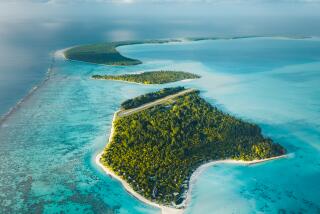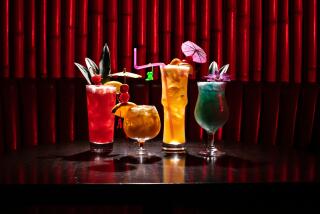Roaming Balmy Crossroads of the South Pacific
- Share via
NADI, Fiji — It’s a tossup which is brighter, the Southern Cross hanging in a flawless South Pacific night or the flash of a Fijian’s full smile, frangipani blossom behind one ear, a cheery “bula” greeting anyone within earshot.
Fiji’s 300-plus islands float on the border of Polynesia and Melanesia, a Pacific crossroads where all of the ocean’s beauty, romance and balmy weather seem to have washed ashore to create a never-never land of milk and honey, the thermometer stuck forever on 75.
Fiji’s history is a sketchy affair, handed down by songs, dances and storytellers. To witness a traditional meke ceremony is to understand the ancient culture of the islands: Fijians are at heart dedicated members of a community, a cooperative group that is always more important than any individual.
What’s amazing is that you’re made to feel a part of that group as soon as your plane lands.
Here to there: Air New Zealand and Qantas fly you here with one stop, Continental with a change in Honolulu. Several hotels are in Nadi on the largest island, Vita Levu; others around its coast, still others on Vanua Levu and on smaller islands between the two. Fiji Air, Air Pacific and Sunflower Airlines get you to some of these areas, cabs to those closer to Nadi. Suva, Fiji’s capital, has a couple of dozen hotels, mainly for visiting officials and business people.
How long/how much? If it’s your destination, stay at least a week. As a stopover to or from Australia-New Zealand, three or four days should do it. Lodging costs are moderate, dining even lower.
A few fast facts: The Fijian dollar bounces between 87 and 97 cents U.S. Come any time of year and bring a full quota of beach wear. Taxi fares from Nadi Airport to hotels along the Coral Coast can climb to $30-$45.
Getting settled in: Dominion International (Queens Road between airport and town; $48 double) has 85 balconied rooms around a garden area with pool. No beach but a good mix of other resort facilities, including a 9-hole pitch-and-putt course, island furnishings in rooms, coffee/tea-making gear, restaurant and bar. Evening entertainment, free van pickup and drop at airport.
Fiji Mocambo (by airport; $65) is another off-the-water place that makes up for it with a gorgeous pool, floodlighted golf driving range and tennis, dining indoors or out. The Mocambo people also have the Fijian Resort (Yanuca Island, Sigatoka area; $104), a huge place right on the beach. A couple of pools, innumerable bars and restaurants, shops, everything you could possibly need or want.
Travelers Beach Motel (Wailoaloa Beach; $28) is a new place with the budget-conscious in mind. Few rooms but they’re all with kitchen gear, right on the beach, near Nadi golf course. This one has only the bare necessities, but the price is right.
Regional food and drink: Seafood takes over most menus here, often prepared with lolo coconut cream and wrapped in taro or banana leaves for roasting or cooking in a lovo pit. Apart from fresh island walu and snapper, try the more exotic coconut-breaded scallops with mango-butter sauce or chilled pawpaw and watermelon soup with mint and yogurt.
Pork seems to be a delicacy on every Pacific island, here prepared at the lovo pit ceremony. Excellent Indian cuisine (half the population is of Indian descent); look for lots of curry dishes and chutney, or the marvelous dhal soup of split peas with fresh island chilies and ginger.
Yaqona is Fiji’s traditional drink, made from pepper root and offered ceremoniously to just about any visitor who shows up at your bure (reed-thatched hut). It must be an acquired taste, as Indians now drink as much or more of it than Fijians, but given the choice, we’ll settle for a Corubadu , a rum drink that makes fire-walking a snap after the second belt.
Moderate-cost dining: India Curry House on Main Street in Nadi is the place for Indian food with its great breads and chutneys. Also on Main you’ll find Poon’s, the favorite of many locals for Chinese food.
Then check local papers for which hotels are having a seafood buffet, Mongolian barbecue, curry night or lovo ceremonial meal. The latter usually includes fish, pork, chicken, beef and root crops cooked in the pit. You can’t go wrong at the Regent of Fiji, Fijian Resort, Dominion International or the Mocambo.
Going first class: Best choice is the Regent of Fiji (Denaru Island; $108 up double) for best capturing the Fijian feeling with its lobby of soaring beams, priceless artifacts and weavings in earth tones, an enormous garden of red ginger flowers, frangipani and glorious yellow allamanda on your balcony. There are also 10 grass and all-weather John Newcombe courts, spacious and elegant rooms that make you feel like a character in a Joseph Conrad novel. Choose from the Ocean Terrace (seafood), Garden Terrace (continental) or Steakhouse dining rooms, relax at the beachside bure .
Every few nights the Regent has a meke ceremony of island song and dance, the men in full warrior costume, women in traditional dress bedecked with flowers. Other nights are for fire-walking, both traditional evenings often coupled with a lovo or barbecue.
On your own: Name your water sport and you’ll find it at just about every beach or cove on Viti Levu. There are also cruises (full and half-day) to offshore islands. But one outing that shouldn’t be missed is the short Sunflower Air flight ($43 round trip) to Pacific Harbor and the Fiji Cultural Center.
We’ve seen our share of such ethnic enclaves, but this is one to remember. It’s a traditional Fijian village set in and around a lake, 10 bures spotted here and there with natives working away at ancient crafts in each: making canoes; weaving; stringing shells; stripping, soaking and pounding the bark of the paper mulberry tree into the lovely tapa or masi cloth.
Guides pole your double-hulled canoe from bure to bure , explain what’s happening and give you an enjoyable crash course in the history and traditions of Fiji.
For additional information: Call the Fiji Visitors Bureau at (213) 417-2234, or write (6151 W. Century Blvd., Los Angeles 90045) for their colorful booklet, “Fiji Calls,” plus a list of island hotels with prices and map. Ask for the Fiji package.
More to Read
Sign up for The Wild
We’ll help you find the best places to hike, bike and run, as well as the perfect silent spots for meditation and yoga.
You may occasionally receive promotional content from the Los Angeles Times.






